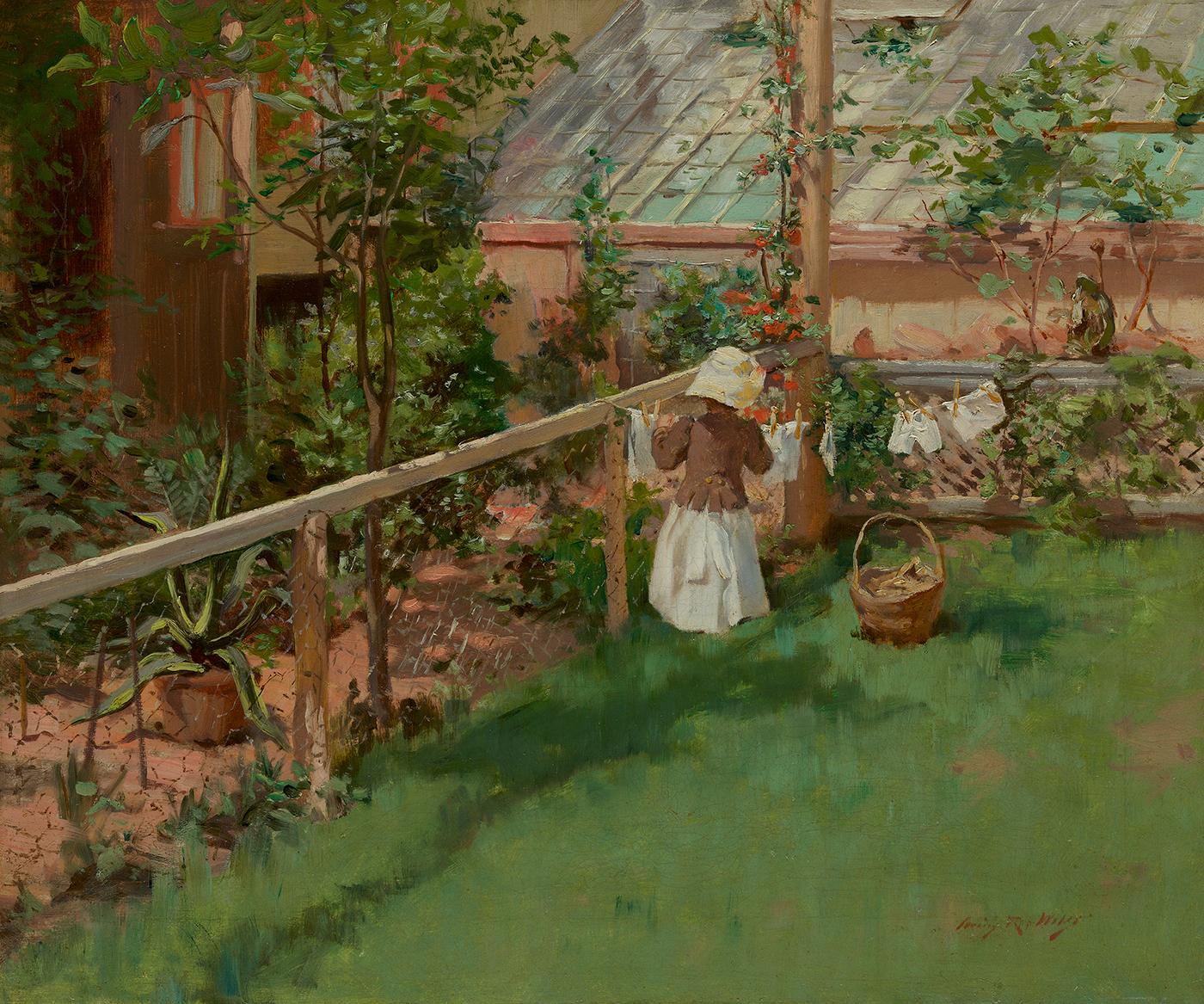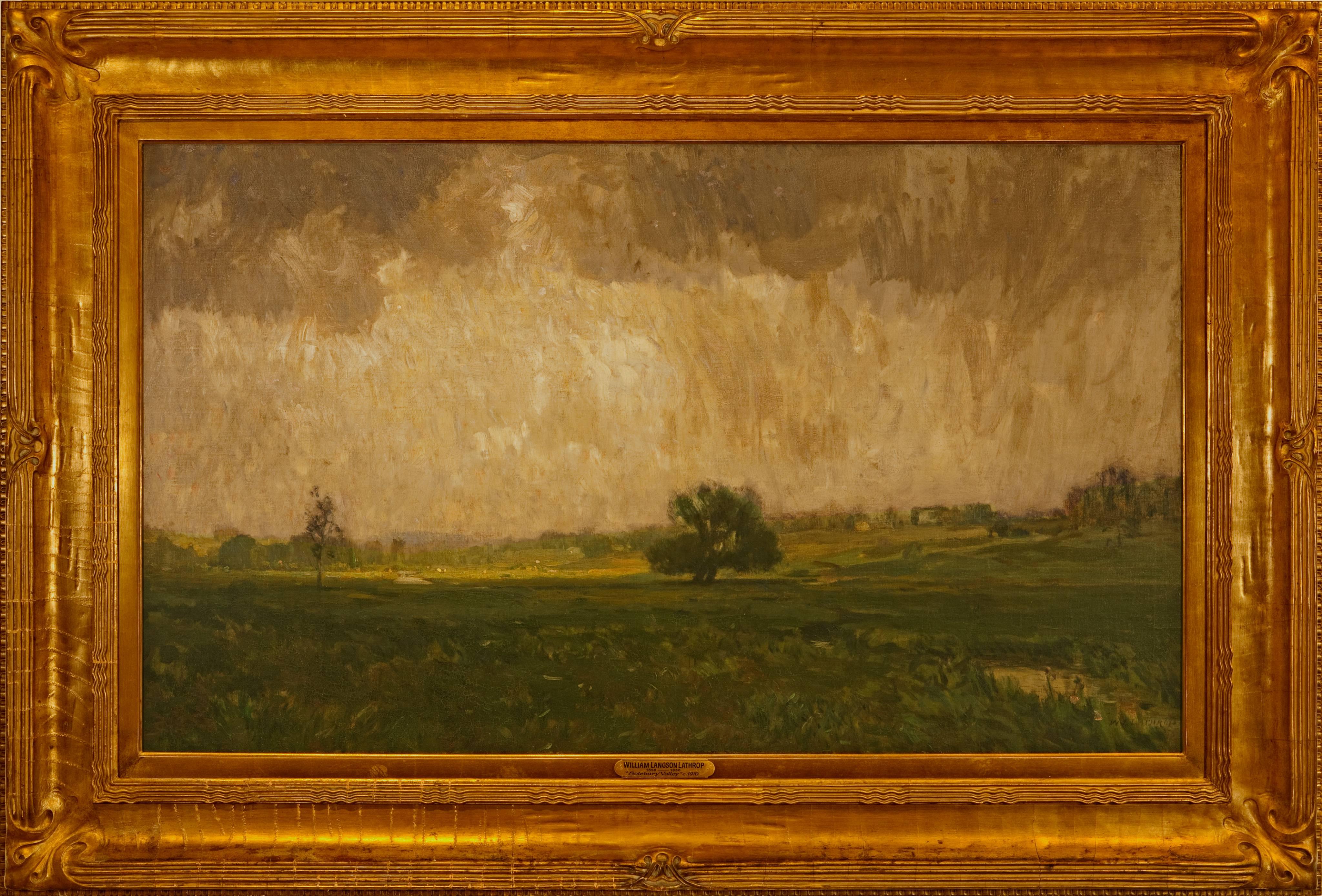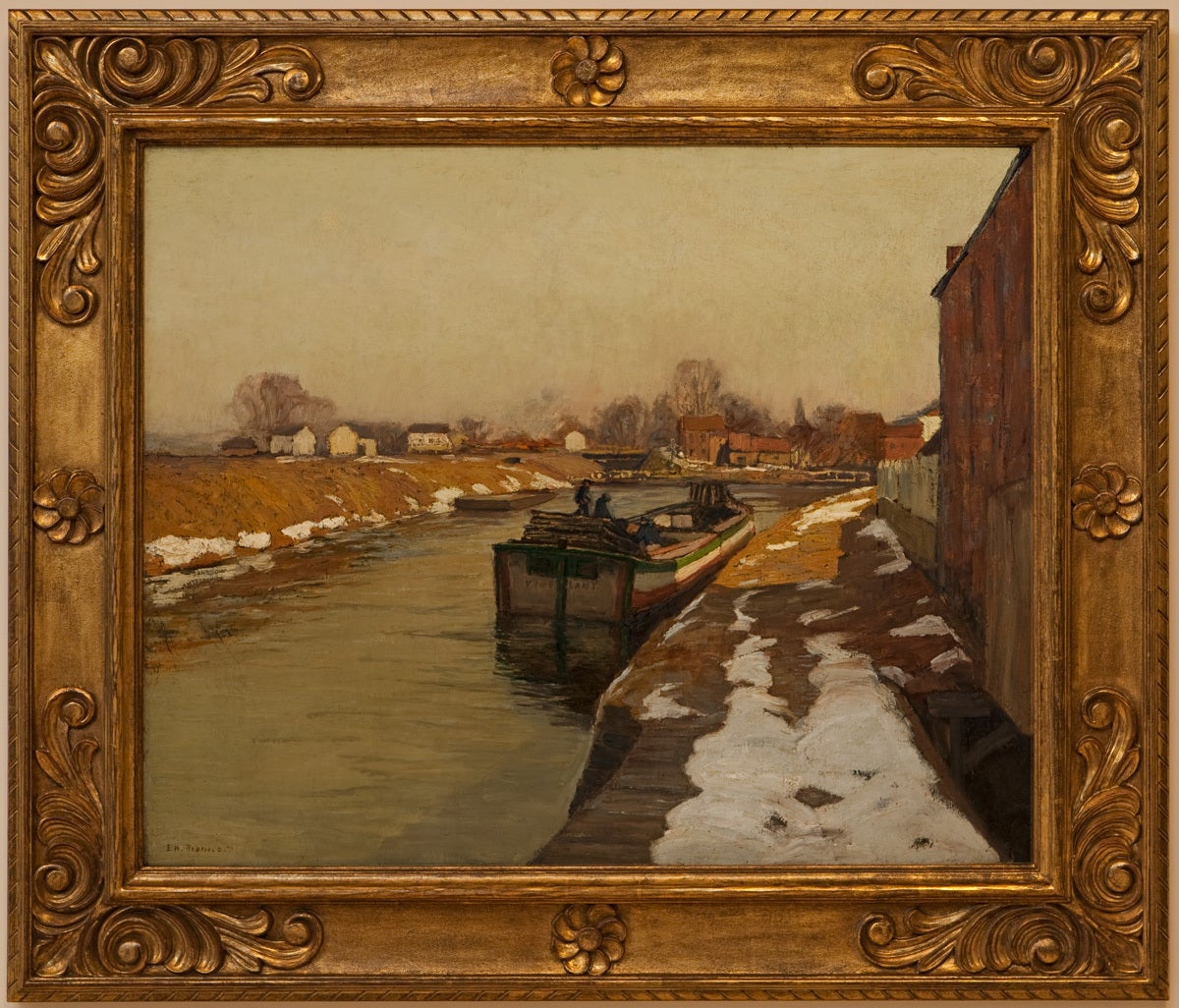Items Similar to The Joy of Spring, American Impressionist Landscape, Farm Scene, Oil on Canvas
Want more images or videos?
Request additional images or videos from the seller
1 of 8
Albert Van Nesse GreeneThe Joy of Spring, American Impressionist Landscape, Farm Scene, Oil on Canvas
About the Item
"Joy of Spring" is an Impressionist landscape with houses and blooming springtime trees by American painter Albert Van Nesse Greene. The painting is a 18.25" x 22.25" oil on canvas, framed in a 22K gold reproduction frame, and signed in the lower right. Provenance: Private Collection, Doylestown, Pennsylvania.
Born in Jamaica, New York in 1887, Albert Van Nesse Greene (American, 1887 - 1971) had a long and thorough art education. He studied at the Corcoran Gallery of Art, Washington, DC; The Art Students League, New York; the Pennsylvania Academy of the Fine Arts, Philadelphia; and in Paris at the Académie de la Grande Chaumiere. He lived in Chester County and painted many landscapes there, as well as in nearby Bucks County. His paintings were exhibited extensively in the United States and France. Examples of his work can be found in the collections of the Pennsylvania Academy of the Fine Arts and the National Gallery of Art among many others. He was a member of the Philadelphia Sketch Club, Society of Independent Artists, and the Yellow Springs Artists Association in Chester County. He exhibited with the Society of Washington Artists, the Pennsylvania Academy, and the Salons of America.
- Creator:Albert Van Nesse Greene (American)
- Dimensions:Height: 26 in (66.04 cm)Width: 30 in (76.2 cm)Depth: 2 in (5.08 cm)
- Medium:
- Movement & Style:
- Period:
- Condition:The painting is in excellent condition, it has been cleaned and varnished. The frame shows some light wear. Additional shipping options are available upon request.
- Gallery Location:Doylestown, PA
- Reference Number:1stDibs: LU140228037682
Albert Van Nesse Greene
Born in Jamaica, New York in 1887, Albert Van Nesse Green had a long and thorough art education. He studied at the Corcoran Gallery of Art, Washington, DC; The Art Students League, New York; the Pennsylvania Academy of the Fine Arts, Philadelphia; and in Paris at the Academie de la Grande Chaumiere. He lived in Chester County and painted many landscapes there, as well as in nearby Bucks County. His paintings were exhibited extensively in the United States and France. Examples of his work can be found in the collections of the Pennsylvania Academy of the Fine Arts and the National Gallery of Art among many others. He was a member of the Philadelphia Sketch Club, Society of Independent Artists, and the Yellow Springs Artists Association in Chester County. He exhibited with the Society of Washington Artists, the Pennsylvania Academy, and the Salons of America.
About the Seller
4.9
Vetted Seller
These experienced sellers undergo a comprehensive evaluation by our team of in-house experts.
Established in 2000
1stDibs seller since 2020
53 sales on 1stDibs
Typical response time: 1 hour
- ShippingRetrieving quote...Ships From: Doylestown, PA
- Return PolicyA return for this item may be initiated within 7 days of delivery.
More From This SellerView All
- Spring Path, American Impressionist Landscape, Oil on CanvasBy Albert Van Nesse GreeneLocated in Doylestown, PA"Spring Path" is an Impressionist landscape with farmhouse and blooming springtime trees by American painter Albert Van Nesse Greene. The painting is a 16" x 20" oil on canvas, framed in a 22K gold reproduction frame, and signed in the lower left. Provenance: Private Collection, Doylestown, Pennsylvania...Category
Early 20th Century American Impressionist Landscape Paintings
MaterialsCanvas, Oil
- Old House, Regional Pennsylvania Impressionist Summer LandscapeBy Walter Emerson BaumLocated in Doylestown, PA"Summer Day" is a 30" x 36" oil on canvas landscape in Bucks County, by Pennsylvania Impressionist and New Hope School painter Walter Emerson Baum. The painting features a rural Buck...Category
1920s American Impressionist Landscape Paintings
MaterialsCanvas, Oil
- Winter in Manayunk, Regional American Cityscape by Pennsylvania ImpressionistBy Giovanni MartinoLocated in Doylestown, PA"Manayunk Houses" is a 28 x 40 inches, oil on canvas, regional, American cityscape by Pennsylvania Impressionist painter Giovanni Martino. Manayunk is a suburb of Philadelphia, Penns...Category
Early 20th Century American Impressionist Landscape Paintings
MaterialsCanvas, Oil
- Manayunk, Regional American Cityscape by Pennsylvania ImpressionistBy Giovanni MartinoLocated in Doylestown, PA"Manayunk" is a 20 x 30 inches, oil on canvas, regional, American cityscape by Pennsylvania Impressionist painter Giovanni Martino. Manayunk is a suburb of Philadelphia, Pennsylvania. The following is from Babette Martino, daughter of the artist: Giovanni Martino, National Academy of Design* member, was born on May 1, 1908 in Philadelphia PA where all seven brothers and one sister, Filomina, Frank, Antonio, Albert, Ernest, Giovanni, Edmond, and William became painters. They were under the tutelage of their eldest brother, Frank, who in the late 1920s, founded the first commercial art studio, Martino Studios, at 27 South 18th Street. Besides studying with his two eldest brothers, Giovanni also studied with Albert Jean Adolph at La France Institute, The Pennsylvania Academy of the Fine Arts, The Graphic Sketch Club, and Spring Garden Institute in Philadelphia. In his mid teens he accompanied his two eldest brothers to New Hope searching for subjects to paint. In the 1930s, he also started to paint in Manayunk, a hilly mill town along the Schuylkill River. At this time he signed his paintings M. Giovanni. These colorful impressionistic works proceeded more thinly painted dramatically poetic street scenes of the mill town. These images developed into impasto laden oils in the 1960's with some of the paintings worked with a palette knife. In Manayunk, he was a common sight on the streets and sidewalks, painting on-the-spot with his wife, Eva Marinelli...Category
Mid-20th Century American Impressionist Landscape Paintings
MaterialsCanvas, Oil
- Bass Rock, New England Seascape by Pennsylvania ImpressionistBy Giovanni MartinoLocated in Doylestown, PA"Bass Rock" is a 8.5 x 10.5 inches, oil on canvas, New England seascape by Pennsylvania Impressionist painter Giovanni Martino. The painting is signed "Giovanni Martino" in the lower right and titled on verso. The following is from Babette Martino, daughter of the artist: Giovanni Martino, National Academy of Design* member, was born on May 1, 1908 in Philadelphia PA where all seven brothers and one sister, Filomina, Frank, Antonio, Albert, Ernest, Giovanni, Edmond, and William became painters. They were under the tutelage of their eldest brother, Frank, who in the late 1920s, founded the first commercial art studio, Martino Studios, at 27 South 18th Street. Besides studying with his two eldest brothers, Giovanni also studied with Albert Jean Adolph at La France Institute, The Pennsylvania Academy of the Fine Arts, The Graphic Sketch Club, and Spring Garden Institute in Philadelphia. In his mid teens he accompanied his two eldest brothers to New Hope searching for subjects to paint. In the 1930s, he also started to paint in Manayunk, a hilly mill town along the Schuylkill River. At this time he signed his paintings M. Giovanni. These colorful impressionistic works proceeded more thinly painted dramatically poetic street scenes of the mill town. These images developed into impasto laden oils in the 1960's with some of the paintings worked with a palette knife. In Manayunk, he was a common sight on the streets and sidewalks, painting on-the-spot with his wife, Eva Marinelli...Category
Early 20th Century American Impressionist Landscape Paintings
MaterialsCanvas, Oil
- Manayunk, Regional American Winter Cityscape by Pennsylvania ImpressionistBy Giovanni MartinoLocated in Doylestown, PA"Manayunk" is a 8 x 12 inches, oil on canvas, regional, winter cityscape by Pennsylvania Impressionist painter Giovanni Martino. Manayunk is a suburb of Philadelphia, Pennsylvania. The painting is signed "Giovanni Martino" in the lower right. The following is from Babette Martino, daughter of the artist: Giovanni Martino, National Academy of Design* member, was born on May 1, 1908 in Philadelphia PA where all seven brothers and one sister, Filomina, Frank, Antonio, Albert, Ernest, Giovanni, Edmond, and William became painters. They were under the tutelage of their eldest brother, Frank, who in the late 1920s, founded the first commercial art studio, Martino Studios, at 27 South 18th Street. Besides studying with his two eldest brothers, Giovanni also studied with Albert Jean Adolph at La France Institute, The Pennsylvania Academy of the Fine Arts, The Graphic Sketch Club, and Spring Garden Institute in Philadelphia. In his mid teens he accompanied his two eldest brothers to New Hope searching for subjects to paint. In the 1930s, he also started to paint in Manayunk, a hilly mill town along the Schuylkill River. At this time he signed his paintings M. Giovanni. These colorful impressionistic works proceeded more thinly painted dramatically poetic street scenes of the mill town. These images developed into impasto laden oils in the 1960's with some of the paintings worked with a palette knife. In Manayunk, he was a common sight on the streets and sidewalks, painting on-the-spot with his wife, Eva Marinelli...Category
Early 20th Century American Impressionist Landscape Paintings
MaterialsCanvas, Oil
You May Also Like
- At the ClotheslineBy Irving Ramsey WilesLocated in New York, NYSigned lower right: Irving R. WilesCategory
Late 19th Century American Impressionist Landscape Paintings
MaterialsCanvas, Oil
- "Alley Fiends"By John R. GrabachLocated in Lambertville, NJJim’s of Lambertville is proud to offer this artwork by: John R. Grabach (1886 - 1981) John Grabach was a highly regarded New Jersey artist, teacher, and author of the classic text...Category
1930s American Impressionist Landscape Paintings
MaterialsCanvas, Oil
- "Forest Strongholds"By John F. CarlsonLocated in Lambertville, NJSigned lower right. Complemented by a hand carved and gilt frame. Exhibited at the National Academy of Design, 1928Category
20th Century American Impressionist Landscape Paintings
MaterialsCanvas, Oil
- "Solebury Valley"By William Langson LathropLocated in Lambertville, NJSigned lower right. Complemented by a period frame. William L. Lathrop (1859-1938) Deemed “Father of the New Hope Art Colony”, William Langson Lathrop was born in Warren, Illinois. He was largely self-taught, having only studied briefly with William Merritt Chase in 1887, at the Art Students League. Lathrop first moved east in the early 1880s, and took a job at the Photoengraving Company in New York City. While there, he befriended a fellow employee, Henry B. Snell. The two men became lifelong friends and ultimately, both would be considered central figures among the New Hope Art Colony. Lathrop's early years as an artist were ones of continuing struggle. His efforts to break through in the New York art scene seemed futile, so he scraped enough money together to travel to Europe with Henry Snell in1888. There he met and married an English girl, Annie Burt. Upon returning to New York, he tried his hand at etching, making tools from old saw blades...Category
1910s American Impressionist Landscape Paintings
MaterialsCanvas, Oil
- Winter MoonlightBy George William SotterLocated in Lambertville, NJsigned lower rightCategory
1910s American Impressionist Landscape Paintings
MaterialsCanvas, Oil
- "The Canal"By Edward Willis RedfieldLocated in Lambertville, NJJim’s of Lambertville is proud to offer this artwork. Signed lower left. Complemented by a hand carved and gilt frame. Illustrated in "Edward Redfield: Just Values and Fine Seeing" by Constance Kimmerle and the Pennsylvania Academy of the Fine Arts's Exhibition of Paintings by Edward Redfield (April 17 to May 16, 1909) brochure Edward Willis Redfield (1869 - 1965) Edward W. Redfield was born in Bridgeville, Delaware, moving to Philadelphia as a young child. Determined to be an artist from an early age, he studied at the Spring Garden Institute and the Franklin Institute before entering the Pennsylvania Academy from 1887 to 1889, where he studied under Thomas Anshutz, James Kelly, and Thomas Hovenden. Along with his friend and fellow artist, Robert Henri, he traveled abroad in 1889 and studied at the Academie Julian in Paris under William Bouguereau and Tony Robert-Fleury. While in France, Redfield met Elise Deligant, the daughter of an innkeeper, and married in London in 1893. Upon his return to the United States, Redfield and his wife settled in Glenside, Pennsylvania. He remained there until 1898, at which time he moved his family to Center Bridge, a town several miles north of New Hope along the Delaware River. Redfield painted prolifically in the 1890s but it was not until the beginning of the twentieth century that he would develop the bold impressionist style that defined his career. As Redfield’s international reputation spread, many young artists gravitated to New Hope as he was a great inspiration and an iconic role model. Edward Redfield remained in Center Bridge throughout his long life, fathering his six children there. Around 1905 and 1906, Redfield’s style was coming into its own, employing thick vigorous brush strokes tightly woven and layered with a multitude of colors. These large plein-air canvases define the essence of Pennsylvania Impressionism. By 1907, Redfield had perfected his craft and, from this point forward, was creating some of his finest work. Redfield would once again return to France where he painted a small but important body of work between 1907 and 1908. While there, he received an Honorable Mention from the Paris Salon for one of these canvases. In 1910 he was awarded a Gold Medal at the prestigious Buenos Aires Exposition and at the Panama-Pacific Exposition of 1915 in San Francisco, an entire gallery was dedicated for twenty-one of his paintings. Since Redfield painted for Exhibition with the intent to win medals, his best effort often went into his larger paintings. Although he also painted many fine smaller pictures, virtually all of his works were of major award-winning canvas sizes of 38x50 or 50x56 inches. If one were to assign a period of Redfield’s work that was representative of his “best period”, it would have to be from 1907 to 1925. Although he was capable of creating masterpieces though the late 1940s, his style fully matured by 1907 and most work from then through the early twenties was of consistently high quality. In the later 1920s and through the 1930s and 1940s, he was like most other great artists, creating some paintings that were superb examples and others that were of more ordinary quality. Redfield earned an international reputation at a young age, known for accurately recording nature with his canvases and painting virtually all of his work outdoors; Redfield was one of a rare breed. He was regarded as the pioneer of impressionist winter landscape painting in America, having few if any equals. Redfield spent summers in Maine, first at Boothbay Harbor and beginning in the 1920s, on Monhegan Island. There he painted colorful marine and coastal scenes as well as the island’s landscape and fishing shacks. He remained active painting and making Windsor style furniture...Category
Early 1900s American Impressionist Landscape Paintings
MaterialsCanvas, Oil
Recently Viewed
View AllMore Ways To Browse
Antique Reproduction Paintings
French Farm House
Pennsylvania Farm
Bucks County Painting
Oil Painting Farm France
Antique Dc
La Farm
Bucks County Landscape
Chester Oil Painting
American Antique Reproduction
Jamaica Sign
Bucks County Impressionists
Chester County
Paris Springtime
Albert Van Nesse Greene
Dallas Vintage
American School 19th Century Portrait Painting
19th Century Rural Scene Painting





